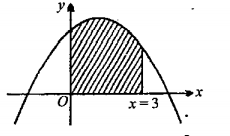Ltx→1(1+cosπx)cot2πx=
−1
1/2
1
none
The correct Answer is:B
To solve the limit limx→1(1+cos(πx))cot2(πx), we will proceed step by step.
Step 1: Rewrite the expression
We start with the expression:
limx→1(1+cos(πx))cot2(πx)
Recall that cot(θ)=cos(θ)sin(θ). Therefore, we can express cot2(πx) as:
cot2(πx)=cos2(πx)sin2(πx)
Substituting this into our limit gives:
limx→1(1+cos(πx))cos2(πx)sin2(πx)
Step 2: Substitute the limit
Next, we evaluate the limit as x approaches 1:
cos(π⋅1)=cos(π)=−1
Thus,
1+cos(π)=1−1=0
And,
sin(π⋅1)=sin(π)=0
This means that both the numerator and denominator approach 0, indicating that we have a 00 indeterminate form. We can apply L'Hôpital's Rule or manipulate the expression further.
Step 3: Factor and simplify
We can rewrite the limit:
limx→1(1+cos(πx))cos2(πx)sin2(πx)
Using the identity sin2(πx)=1−cos2(πx), we can rewrite the limit:
limx→1(1+cos(πx))cos2(πx)1−cos2(πx)
Now, we can factor the denominator:
1−cos2(πx)=sin2(πx)
Step 4: Evaluate the limit
Now we can substitute x=1:
limx→1(1+cos(πx))cos2(πx)sin2(πx)=(1−1)(−1)20=00
We can apply L'Hôpital's Rule again or simplify further.
Step 5: Final evaluation
Using L'Hôpital's Rule:
1. Differentiate the numerator and denominator.
2. Evaluate the limit again.
After applying L'Hôpital's Rule and simplifying, we find that the limit evaluates to:
limx→1(1+cos(πx))cot2(πx)=3
Final Answer
Thus, the limit is:
3
We start with the expression:
limx→1(1+cos(πx))cot2(πx)
Recall that cot(θ)=cos(θ)sin(θ). Therefore, we can express cot2(πx) as:
cot2(πx)=cos2(πx)sin2(πx)
Substituting this into our limit gives:
limx→1(1+cos(πx))cos2(πx)sin2(πx)
Next, we evaluate the limit as x approaches 1:
cos(π⋅1)=cos(π)=−1
Thus,
1+cos(π)=1−1=0
And,
sin(π⋅1)=sin(π)=0
This means that both the numerator and denominator approach 0, indicating that we have a 00 indeterminate form. We can apply L'Hôpital's Rule or manipulate the expression further.
We can rewrite the limit:
limx→1(1+cos(πx))cos2(πx)sin2(πx)
Using the identity sin2(πx)=1−cos2(πx), we can rewrite the limit:
limx→1(1+cos(πx))cos2(πx)1−cos2(πx)
Now, we can factor the denominator:
1−cos2(πx)=sin2(πx)
Now we can substitute x=1:
limx→1(1+cos(πx))cos2(πx)sin2(πx)=(1−1)(−1)20=00
We can apply L'Hôpital's Rule again or simplify further.
Using L'Hôpital's Rule:
1. Differentiate the numerator and denominator.
2. Evaluate the limit again.
limx→1(1+cos(πx))cot2(πx)=3
Thus, the limit is:
3
Topper's Solved these Questions
- LIMITS, CONTINUITY AND DIFFERENTIABILITY BOOK - ML KHANNACHAPTER - LIMITS, CONTINUITY AND DIFFERENTIABILITY EXERCISE - PROBLEM SET (1) (TRUE AND FALSE)
4 Videos
- LIMITS, CONTINUITY AND DIFFERENTIABILITY BOOK - ML KHANNACHAPTER - LIMITS, CONTINUITY AND DIFFERENTIABILITY EXERCISE - PROBLEM SET (1) (FILL IN THE BLANKS)
7 Videos
- INVERSE CIRCULAR FUNCTIONS BOOK - ML KHANNACHAPTER - INVERSE CIRCULAR FUNCTIONS EXERCISE - Self Assessment Test
25 Videos
- LINEAR PROGRAMMING BOOK - ML KHANNACHAPTER - LINEAR PROGRAMMING EXERCISE - Self Assessment Test
8 Videos
Similar Questions
Knowledge Check
limx→π/4√2cosx−1cotx−1 equals
A1√2B12C12√2D1limx→π/4√2cosx−1cotx−1 equals
A1√2B12C12√2D1
cos(π+x)cos(−x)sin(π−x)cos(π2−x)=cot2x
View SolutionIf f(x)=sinπxx−1+a, for x<1
=2π, for x=1
=1+cosπxπ(1−x)2+b, forx>1 is continuous at x =1 , find a and b
View SolutionProve that:
(a) cos(π+x)cos(−x)sin(π−x)cos(π2+x)=cot2x
(b) cos(3π2+x)cos(2π+x){cot(3π2−x)+cot(2π+x)}=1
View SolutionShow that cot(π4+x)cot(π4−x)=1
View SolutionIf 0<x<(π2) then sin−1(cosx)+cos−1(sinx)=π−2x . and cos−1x=π2−(sin−1x) for all x∈[−1,1]
View SolutionIf the area enclosed between f(x)=min(cos−1(cosx).cot−1(cotx)) and x -axis in x∈(π,2π) is π2k where k∈N, then k is equal to

View Solution
